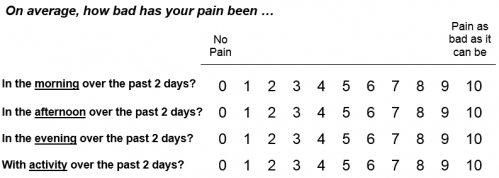4-Item Pain Intensity Measure (P4): Difference between revisions
Evan Thomas (talk | contribs) mNo edit summary |
Evan Thomas (talk | contribs) mNo edit summary |
||
| Line 2: | Line 2: | ||
'''Original Editor '''- Your name will be added here if you created the original content for this page. | '''Original Editor '''- Your name will be added here if you created the original content for this page. | ||
'''Top Contributors''' - {{Special:Contributors/{{FULLPAGENAME}}}} | '''Top Contributors''' - {{Special:Contributors/{{FULLPAGENAME}}}} | ||
</div> | </div> | ||
== Summary == | == Summary == | ||
The P4 consists of 4 items that address pain intensity in the morning, afternoon, evening, and with activity over the past 2 days. Each item is scored on a 0-to-10 NPRS, therefore the total P4 scores can vary from 0 (no pain) to 40 (the highest possible pain level). Most patients can complete the P4 in less than a minute and clinicians can score the measure in 5 seconds without the use of computational aids. | The P4 consists of 4 items that address pain intensity in the morning, afternoon, evening, and with activity over the past 2 days. Each item is scored on a 0-to-10 NPRS, therefore the total P4 scores can vary from 0 (no pain) to 40 (the highest possible pain level). Most patients can complete the P4 in less than a minute and clinicians can score the measure in 5 seconds without the use of computational aids. | ||
The purpose of developing this questionnaire was to attempt assessing change better than the two difference versions of a single-item NPRS. | The purpose of developing this questionnaire was to attempt assessing change better than the two difference versions of a single-item NPRS. | ||
== Intended Population == | == Intended Population == | ||
Those over the age of 16 with non-chronic musculoskeletal pain. It has also been shown to be valid when used in conjunction with the WOMAC in people with osteoarthritis awaiting total knee or total hip replacements.<ref name="Stratford 2009">Stratford PW, Dogra M, Woodhouse L, Kennedy DM, Spadoni GF. Validating Self-Report Measures of Pain and Function in Patients Undergoing Hip or Knee Arthroplasty. Physiother Can, 2009: 61; 189-194.</ref> | Those over the age of 16 with non-chronic musculoskeletal pain. It has also been shown to be valid when used in conjunction with the WOMAC in people with osteoarthritis awaiting total knee or total hip replacements.<ref name="Stratford 2009">Stratford PW, Dogra M, Woodhouse L, Kennedy DM, Spadoni GF. Validating Self-Report Measures of Pain and Function in Patients Undergoing Hip or Knee Arthroplasty. Physiother Can, 2009: 61; 189-194.</ref> | ||
== Method of Use == | == Method of Use == | ||
[[Image:P4 Questionnaire.png|center|500x178px]] | [[Image:P4 Questionnaire.png|center|500x178px]] | ||
<br> | |||
Patients are asked to circle a single number that corresponds to their pain at each time of day and with activity over the previous 2 days. | |||
Patients are asked to circle a single number that corresponds to their pain at each time of day and with activity over the previous 2 days. | |||
== Evidence == | == Evidence == | ||
| Line 32: | Line 30: | ||
=== Responsiveness === | === Responsiveness === | ||
=== Miscellaneous | === Miscellaneous<br> === | ||
== Links == | == Links == | ||
Revision as of 03:25, 7 March 2014
Original Editor - Your name will be added here if you created the original content for this page.
Top Contributors - Evan Thomas, Andeela Hafeez, WikiSysop and Melissa Coetsee
Summary[edit | edit source]
The P4 consists of 4 items that address pain intensity in the morning, afternoon, evening, and with activity over the past 2 days. Each item is scored on a 0-to-10 NPRS, therefore the total P4 scores can vary from 0 (no pain) to 40 (the highest possible pain level). Most patients can complete the P4 in less than a minute and clinicians can score the measure in 5 seconds without the use of computational aids.
The purpose of developing this questionnaire was to attempt assessing change better than the two difference versions of a single-item NPRS.
Intended Population[edit | edit source]
Those over the age of 16 with non-chronic musculoskeletal pain. It has also been shown to be valid when used in conjunction with the WOMAC in people with osteoarthritis awaiting total knee or total hip replacements.[1]
Method of Use[edit | edit source]
Patients are asked to circle a single number that corresponds to their pain at each time of day and with activity over the previous 2 days.
Evidence[edit | edit source]
Reliability[edit | edit source]
Validity[edit | edit source]
Responsiveness[edit | edit source]
Miscellaneous
[edit | edit source]
Links[edit | edit source]
Recent Related Research (from Pubmed)[edit | edit source]
Extension:RSS -- Error: Not a valid URL: Feed goes here!!|charset=UTF-8|short|max=10
References[edit | edit source]
- ↑ Stratford PW, Dogra M, Woodhouse L, Kennedy DM, Spadoni GF. Validating Self-Report Measures of Pain and Function in Patients Undergoing Hip or Knee Arthroplasty. Physiother Can, 2009: 61; 189-194.







